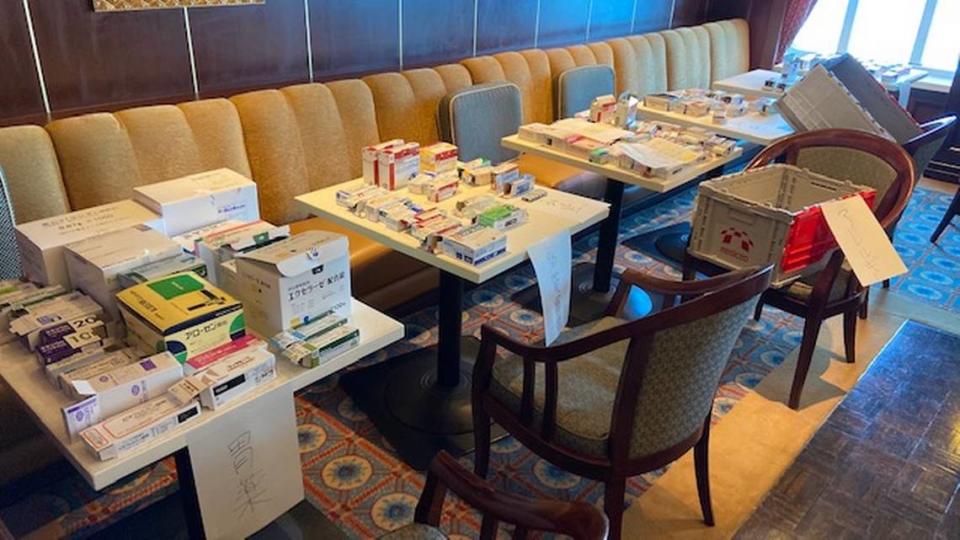Japan pharmacists filled 2,000 scripts for quarantined cruisers needing medications
Many of the 2,666 passengers who boarded the Diamond Princess cruise ship in Yokohama, Japan on Jan. 20 had travel pill packs in tow, holding just the right amount of prescription medication to get them through their 14-day vacation.
Little did they know that that vacation would soon turn into a confinement.
A passenger who got off the ship in Hong Kong tested positive for coronavirus, or COVID-19, on Feb. 1. By Feb. 4, the ship had reached its final destination of Yokohama. But instead of disembarking and traveling home, the passengers and crew would remain quarantined on the ship for 14 more days, many in complete isolation inside their cabins.
Immediately, concerned passengers began to make calls to 911 and the ship’s guest services desk. One passenger resorted to hanging a Japanese flag with the message “Medicine” from her balcony on Feb. 7. Family and friends took to social media to urge the company, Princess Cruises, owned by Miami-based Carnival Corp., to act.

The ship, now under the control of the Japanese government, was faced with a challenge: how to help source prescription drugs for thousands of elderly passengers from 56 countries.
“We quickly realized guests hadn’t brought enough medications for weeks after that,” said Grant Tarling, the chief medical officer for the cruise company. “When you’ve got thousands of people on board, this becomes a really big issue when you realize you’re going to be in a 14-day quarantine.”
The company is not allowed to bring any additional crew on board the ship. From California, where Princess Cruises is based, Tarling said he began to coordinate with the ship’s crew to get a prescription survey to every passenger. Passengers were asked to provide the trade name of the medication, the generic name, the dose and the number of days needed, followed by a question to help with triage: Do you need any of this medication in the next 24 hours?
Crew members collected the data and turned it over to the Japanese Ministry of Health. What happened next was nothing short of herculean. The Japanese government allowed 45 Japanese pharmacists to board the ship, and they took over one of the dining rooms with thousands of medications. Over the next few days, the pharmacists worked to confirm they had the right drugs for each passenger.
“It was a slow, laborious process,” said Tarling. “Some people said, ‘I have the pink one for my heart.’ Most people bring travel packs for the length of the cruise.”
Some medications arrived via packages from family members. The army of pharmacists sourced the rest of the medications, then sorted, packaged and delivered 2,000 prescriptions. Crew members who needed medicine were able to fill their prescriptions at the regular on-board pharmacy, Tarling said.
Aunt and uncle receive medication finally on the #DiamondPrincess cruise ship in Japan #クルーズ船 #CoronavirusOutbreak #Coronavius pic.twitter.com/nuSezhaJX8
— Virginia Lau (@virginiaylau) February 11, 2020
“We understand all the issues better now,” said Tarling. “We’ve got workflows, processes in place supported by the Japanese Ministry of Health. Things have become more stable on board and everyone is looking forward to the end of the quarantine. Everyone has their sights set on that.”
Never in the history of the industry has a cruise ship been held under a government quarantine. The response to the coronavirus quarantine on the Diamond Princess is a stark contrast to cruise emergencies past.
In 2013, more than 4,000 passengers and crew members aboard the Carnival Triumph were stranded at sea in the Gulf of Mexico for four days without air conditioning and working toilets because the ship’s engine stopped working. Passengers created makeshift tents with old bed sheets to sleep on the open decks. The response was largely viewed as insufficient and the ordeal has since been dubbed the “poop cruise” for the unsanitary conditions on board.
The Diamond Princess quarantine is scheduled to end on Feb. 19, but may extend past that date for people who have been in close contact with those who have contracted COVID-19. So far, 285 people on the ship have tested positive, according to the Associated Press, including at least 21 crew members, the company said. One Japanese health officer also tested positive.
COVID-19 is a respiratory illness that has killed more than 1,300 people worldwide and has infected nearly 50,000 people across more than 25 countries, including the United States, since it was first identified in Wuhan, China in December. The majority of those who are infected live in China.

